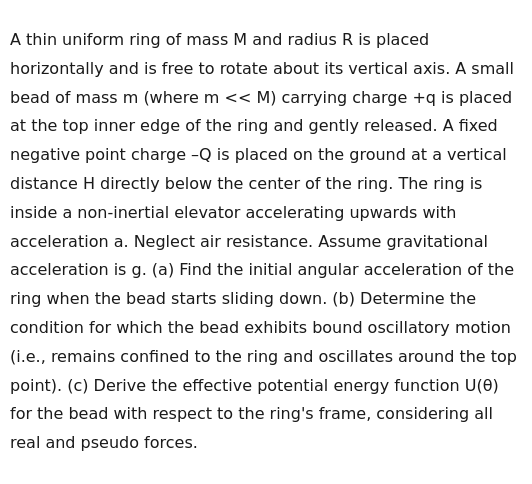Question
Question: A thin uniform ring of mass M and radius R is placed horizontally and is free to rotate about its ve...
A thin uniform ring of mass M and radius R is placed horizontally and is free to rotate about its vertical axis. A small bead of mass m (where m << M) carrying charge +q is placed at the top inner edge of the ring and gently released. A fixed negative point charge –Q is placed on the ground at a vertical distance H directly below the center of the ring. The ring is inside a non-inertial elevator accelerating upwards with acceleration a. Neglect air resistance. Assume gravitational acceleration is g. (a) Find the initial angular acceleration of the ring when the bead starts sliding down. (b) Determine the condition for which the bead exhibits bound oscillatory motion (i.e., remains confined to the ring and oscillates around the top point). (c) Derive the effective potential energy function U(θ) for the bead with respect to the ring's frame, considering all real and pseudo forces.

The problem statement is inconsistent and cannot be solved with the given information.
Solution
The problem is ill-posed due to inconsistencies in the setup. The forces described (gravity, electric force) do not provide a tangential component along the horizontal ring that would cause the bead to slide down from rest. Therefore, a solution based on the given information and standard physics principles is not possible.
If we were to assume a potential energy function U(θ) exists that governs the bead's motion along the ring, then:
-
(a) Initial angular acceleration of the ring:
\ddot{\phi}{initial} = \frac{1}{MR^2} \frac{dU}{d\theta}|{\theta=0} -
(b) Condition for bound oscillatory motion around θ=0:
\frac{dU}{d\theta}|{\theta=0} = 0 and \frac{d^2U}{d\theta^2}|{\theta=0} > 0 -
(c) Effective potential energy function:
U(θ)
However, without a specific form for U(θ) derived from the problem statement, a quantitative solution cannot be provided.
